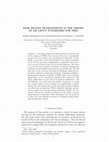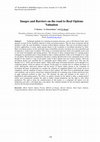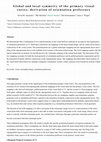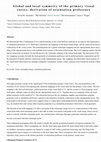Papers by Otto Konstandatos

Insurance: Mathematics and Economics, 2016
Employee stock options (ESOs) are highly exotic derivatives including various forms of call optio... more Employee stock options (ESOs) are highly exotic derivatives including various forms of call options and performance shares. Much effort in the academic literature has been devoted to modelling employee risk aversion and early exercise of ESOs and less attention has been paid to the effects of employee attrition during the lifetime of the ESO. We show that under the exercise multiple approach proposed by Hull and White (2004), an employee stock option can be decomposed into a gap call option and two partial time barrier options. Analytic formulae for these are derived using the Method of Images developed in Buchen (2001); Konstandatos (2003, 2008) and European exotic bivariate power options (Kyng, 2011). We propose an actuarial approach to incorporate employee attrition into the valuation method. Using exit probabilities obtained from empirically determined multiple decrement tables or life tables we model stock price independent causes of involuntary exercise or forfeiture of ESOs. This allows us to construct a portfolio of analytically tractable ESOs to obtain a valuation which correctly accounts for employee attrition. This is an alternative to the approaches used by Gerber et al. (2012) and Cvitanic et al. (2008) which attempt to model employee attrition without an empirically determined set of exit probabilities.
VDM Verlag Dr. Müller, Aug 17, 2008

Lie group symmetry methods provide a powerful tool for the analysis of PDEs. Over the last thirty... more Lie group symmetry methods provide a powerful tool for the analysis of PDEs. Over the last thirty years, considerable progress has been made in the development of this field. In this article, we provide a brief introduction to the method developed by Lie for the systematic computation of symmetries, then move on to a survey of some of the more recent developments. Our focus is on the use of Lie symmetry methods to construct fundamental solutions of partial dierential equations of parabolic type. We will show how recent work has uncovered an intriguing connection be- tween Lie symmetry analysis and the theory of integral transforms. Fundamental solutions of families of PDEs which arise in various applications, can be obtained by exploiting this connection. The major applications we give will be in financial mathematics. We will illustrate our results with the problem of pricing a so called zero coupon bond, as well as giving some applications to option pricing. We also discuss some r...

The economic valuation of complex financial contracts is often done using Monte-Carlo simulation.... more The economic valuation of complex financial contracts is often done using Monte-Carlo simulation. We show how to implement this approach using Excel. We discuss Monte-Carlo evaluation for standard single asset European options and then demonstrate how the basic ideas may be extended to evaluate options with exotic multi-asset multi-period features. Single asset option evaluation becomes a special case. We use a typical Executive Stock Option to motivate the discussion, which we analyse using novel theory developed in our previous works. We demonstrate the simulation of the multivariate normal distribution and the multivariate Log-Normal distribution using the Cholesky Square Root of a covariance matrix for replicating the correlation structure in the multi-asset, multi period simulation required for estimating the economic value of the contract. We do this in the standard Black Scholes framework with constant parameters. Excel implementation provides many pedagogical merits due to i...
We develop novel methods for efficient analytical solution of all types of partial time barrier o... more We develop novel methods for efficient analytical solution of all types of partial time barrier options with both single and double exponential and time varying boundaries, and specifically to treat forward-starting partial double barrier options, which present the simplest non-trivial example of the multiple exponential time-varying barrier case. Our methods reduce the pricing of all barrier options with time-varying boundaries to the pricing of a single European option. We express our novel results solely in terms of European first and second order Gap options. We are motivated by similar structures appearing in Structural Credit Risk models for firm default.

Annals of Actuarial Science
Executive stock options (ESOs) are widely used to reward employees and represent major items of c... more Executive stock options (ESOs) are widely used to reward employees and represent major items of corporate liability. The International Accounting Standards Board IFRS9 financial reporting standard which came into full effect on 1-Jan 2018, along with its Australian implementation AASB9, requires public corporations to report their fair-value cost in financial statements. Reset ESOs are typically issued to re-incentivise employees by allowing the option to be cancelled and re-issued with a lower exercise price or later maturity. We produce a novel analytical Reset ESO valuation consistent with the IFRS9 financial reporting standard incorporating the simultaneous resetting of vesting period, exercise window, reset level and maturity. We allow for voluntary and involuntary exercise. Our analytical result is expressed solely in terms of standardised European binary power option instruments. Using the multi-state mortality model of Hariyanto (2014, Mortality and disability modelling with...
Applied Mathematical Finance, Jul 15, 2008
This paper formally analyses two exotic options with lookback features, referred to as extreme sp... more This paper formally analyses two exotic options with lookback features, referred to as extreme spread lookback options and look‐barrier options, first introduced by Bermin. The holder of such options receives partial protection from large price movements in the underlying, but at roughly the cost of a plain vanilla contract. This is achieved by increasing the leverage through either floating the

Traditional methods for evaluating investment decisions, such as Net Present Value, don't properl... more Traditional methods for evaluating investment decisions, such as Net Present Value, don't properly account for the flexibility inherent in many investment projects. This has been recognized and the attempt to value the such flexibilities is known as Real Options Analysis. This type of investment analysis involves applications of exotic option pricing theory to the evaluation of investment decisions by firms. Many investment projects involve particular types of flexibility and these situations have been identified and recognized as various types of options. This relates to investment decisions about non tradeable assets such as real estate development and mining projects. The decision to delay commencement of a mining project contingent on commodity prices rising enough to make a mining operation viable can be thought of as a type of call option. The decision to temporarily shut down a mining operation due to low commodity prices can be thought of and valued as a type of put option. Some of these options may have barrier features, where the investment project gets cancelled due to commodity prices falling below a critical level. This may the thought of as a "down and out barrier option". Many multi-stage investment decisions can be thought of as compound options, which are options over options. In this paper we consider how to combine the theory of exotic multi-period, multi-asset options and the theory of barrier option pricing to the evaluation of investment decisions. In particular we consider the valuation of compound options with various levels of complexity, and the valuation of barrier versions of these options. We show how to mathematically model such situations, and we derive closed form valuation formulae for evaluating some of them and discuss how to apply numerical methods in other cases. We illustrate the ideas and methods in the context of a hypothetical gold mining project. We derive an analytic formula for the option to delay a mining project which, once commenced, includes the right to further expand production and the right to close down production. The right to delay the commencement of this project is a compound call option over the underlying asset plus a call option plus a put option. The valuation formula for this investment opportunity involves the bivariate normal distribution.

We demonstrate that a combination of two transformations of the visual field are sufficient to ac... more We demonstrate that a combination of two transformations of the visual field are sufficient to account for the organisation of orientation preference in V1. Both these transforms are mappings of the hemi-retinal image, and are achieved by known connectivity in the visual system. The transformations are a global retinotopic mapping into the supragranular layers and a tiling of the supragranular layers with multiple local versions of the hemi-retinal image. The local mapping requires that the lateral connections in laminae 4A and 4B preserve the visuotopic ordering of the retinal hemi-field. The interaction of the two mappings accounts for both the local geometry of orientation preference and its global geometric organisation and for the formation of patchy intrinsic connections in the supragranular layers. The mappings described allow those features of the visual field which tend to be spatially contiguous (orientation, texture, colour, contrast) to be learned by neurons within V1.
Spreadsheets in Education, 2014

We demonstrate that a combination of two transformations of the visual field are sufficient to ac... more We demonstrate that a combination of two transformations of the visual field are sufficient to account for the organisation of orientation preference in V1. Both these transforms are mappings of the hemi-retinal image, and are achieved by known connectivity in the visual system. The transformations are a global retinotopic mapping into the supragranular layers and a tiling of the supragranular layers with multiple local versions of the hemi-retinal image. The local mapping requires that the lateral connections in laminae 4A and 4B preserve the visuotopic ordering of the retinal hemi-field. The interaction of the two mappings accounts for both the local geometry of orientation preference and its global geometric organisation and for the formation of patchy intrinsic connections in the supragranular layers. The mappings described allow those features of the visual field which tend to be spatially contiguous (orientation, texture, colour, contrast) to be learned by neurons within V1.

Vision Research, 2004
The local-global map hypothesis states that locally organized response properties-such as orienta... more The local-global map hypothesis states that locally organized response properties-such as orientation preference-result from visuotopically organized local maps of non-retinotopic response properties. In the tree shrew, the lateral extent of horizontal patchy connections is as much as 80-100% of V1 and is consistent with the length summation property. We argue that neural signals can be transmitted across the entire extent of V1 and this allows the formation of maps at the local scale that are visuotopically organized. We describe mechanisms relevant to the formation of local maps and report modeling results showing the same patterns of horizontal connectivity, and relationships to orientation preference, seen in vivo. The structure of the connectivity that emerges in the simulations reveals a Ôhub and spoke' organization. Singularities form the centers of local maps, and linear zones and saddle-points arise as smooth border transitions between maps. These findings are used to present the case for the local-global map hypothesis for tree shrew V1.

Employee stock options (ESOs) are highly exotic derivatives including various forms of call optio... more Employee stock options (ESOs) are highly exotic derivatives including various forms of call options and performance shares. Much effort in the academic literature has been devoted to modelling employee risk aversion and early exercise of ESOs and less attention has been paid to the effects of employee attrition during the lifetime of the ESO. We show that under the exercise multiple approach proposed by Hull and White (2004), an employee stock option can be decomposed into a gap call option and two partial time barrier options. Analytic formulae for these are derived using the Method of Images developed in Buchen (2001); Konstandatos (2003, 2008) and European exotic bivariate power options (Kyng, 2011). We propose an actuarial approach to incorporate employee attrition into the valuation method. Using exit probabilities obtained from empirically determined multiple decrement tables or life tables we model stock price independent causes of involuntary exercise or forfeiture of ESOs. This allows us to construct a portfolio of analytically tractable ESOs to obtain a valuation which correctly accounts for employee attrition. This is an alternative to the approaches used by Gerber et al. (2012) and Cvitanic et al. (2008) which attempt to model employee attrition without an empirically determined set of exit probabilities.
Archives of Business Research, 2015
Accounting and Finance Research, 2012

Mathematical Finance, 2005
A new method for pricing lookback options (a.k.a. hindsight options) is presented, which simplifi... more A new method for pricing lookback options (a.k.a. hindsight options) is presented, which simplifies the derivation of analytical formulas for this class of exotics in the Black-Scholes framework. Underlying the method is the observation that a lookback option can be considered as an integrated form of a related barrier option. The integrations with respect to the barrier price are evaluated at the expiry date to derive the payoff of an equivalent portfolio of European-type binary options. The arbitrage-free price of the lookback option can then be evaluated by static replication as the present value of this portfolio. We illustrate the method by deriving expressions for generic, standard floating-, fixed-, and reverse-strike lookbacks, and then show how the method can be used to price the more complex partial-price and partial-time lookback options. The method is in principle applicable to frameworks with alternative asset-price dynamics to the Black-Scholes world.







Uploads
Papers by Otto Konstandatos